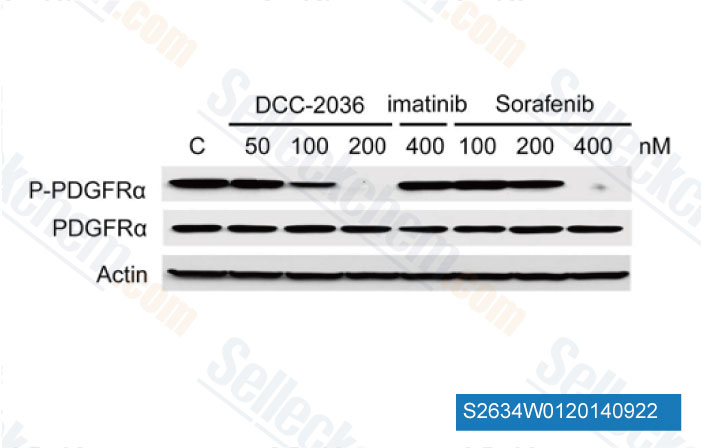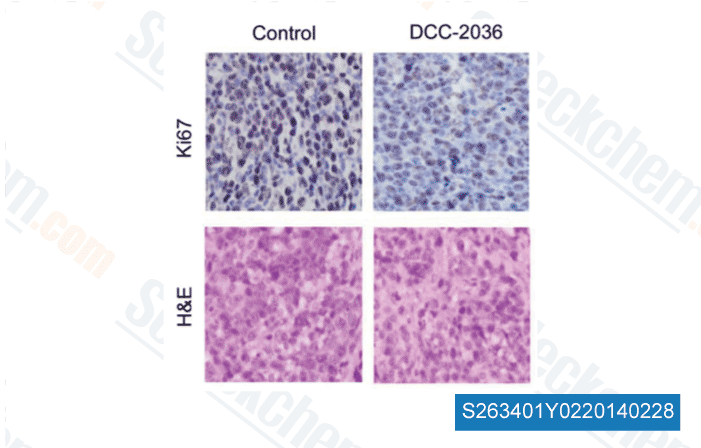|
How to Cite 1. For In-Text Citation (Materials & Methods): 2. For Key Resources Table: |
||
|
Toll Free: (877) 796-6397 -- USA and Canada only -- |
Fax: +1-832-582-8590 Orders: +1-832-582-8158 |
Tech Support: +1-832-582-8158 Ext:3 Please provide your Order Number in the email. We strive to reply to |
Technical Data
| Formula | C30H28FN7O3 |
||||||
| Molecular Weight | 553.59 | CAS No. | 1020172-07-9 | ||||
| Solubility (25°C)* | In vitro | DMSO | 111 mg/mL (200.5 mM) | ||||
| Ethanol | 18 mg/mL (32.51 mM) | ||||||
| Water | Insoluble | ||||||
| In vivo (Add solvents to the product individually and in order) |
|
||||||
|
* <1 mg/ml means slightly soluble or insoluble. * Please note that Selleck tests the solubility of all compounds in-house, and the actual solubility may differ slightly from published values. This is normal and is due to slight batch-to-batch variations. * Room temperature shipping (Stability testing shows this product can be shipped without any cooling measures.) |
|||||||
Preparing Stock Solutions
Biological Activity
| Description | Rebastinib (DCC-2036) is a conformational control Bcr-Abl inhibitor with IC50 values of 0.8 nM and 4 nM for Abl1(WT) and Abl1(T315I), respectively. It also inhibits SRC, LYN, FGR, HCK, KDR, FLT3, and Tie-2, and has low activity towards c-Kit. This compound is in Phase 1. | |||||||||||
|---|---|---|---|---|---|---|---|---|---|---|---|---|
| Targets |
|
|||||||||||
| In vitro | Rebastinib (DCC-2036) shows potent inhibitory activities against purified native Abl1 in unphosphorylated (u-Abl1native) and phosphorylated (p-Abl1native) forms, unphosphorylated and phosphorylated gatekeeper mutant Abl1T315I, and the activation loop mutant Abl1H396P in a non-ATP-competitive manner with IC50 values of 0.8 nM, 2 nM, 1.4 nM, 5 nM, and 4 nM, respectively. Moreover, it also inhibits the Src family kinases Src, LYN, FGR, and HCK, and the receptor TKs KDR, FLT3, and TIE2 with IC50 values of 34 nM, 29 nM, 38 nM, 40 nM, 4 nM, 2 nM and 6 nM, respectively. [1] This compound shows anti-proliferative activities against Ba/F3 cells expressing native or mutant Bcr-Abl1 with IC50 ranging from 2 nM to 150 nM. In addition, it also inhibits proliferation of the Ph+ cell line K562 (IC50 5.5 nM), and induces apoptosis in both Bcr-Abl1-expressing Ba/F3 and K562 cells potently. [1] A recent study shows that it exhibits selectivity for growth inhibition of Bcr-Abl-positive cells by its marked inhibition of CML cell lines compared to non-CML leukemia lines. [2] | |||||||||||
| In vivo | In a mouse allograft model bearing Ba/F3-Bcr-Abl1T315I leukemia cells, treatment with Rebastinib (DCC-2036) by oral gavage at 100 mg/kg once daily effectively inhibits Bcr-Abl1 signaling and significantly prolongs mouse survival. [1] | |||||||||||
| Features | A conformational control inhibitor of Abl1 and T315I Abl1. |
Protocol (from reference)
| Kinase Assay:[1] |
|
|---|---|
| Cell Assay:[1] |
|
| Animal Study:[1] |
|
References
|
Customer Product Validation

-
Data from [ PLoS One , 2013 , 8, e73059 ]

-
Data from [ PLoS One , 2013 , 8, e73059 ]

-
Data from [ , , Int J Cancer, 2018, doi:10.1002/ijc.31915 ]
Selleck's Rebastinib (DCC-2036) Has Been Cited by 19 Publications
| Enhancing immunotherapy efficacy in colorectal cancer: targeting the FGR-AKT-SP1-DKK1 axis with DCC-2036 (Rebastinib) [ Cell Death Dis, 2025, 16(1):8] | PubMed: 39788945 |
| Rebastinib attenuates acute lung injury by promoting NLRP3 ubiquitination and blocking NLRP3/GSDMD signaling pathway in macrophages and protecting alveolar epithelial cells [ Int Immunopharmacol, 2025, 159:114819] | PubMed: 40403501 |
| DCC-2036 inhibits osteosarcoma via targeting HCK and the PI3K/AKT-mTORC1 axis to promote autophagy [ World J Surg Oncol, 2025, 23(1):115] | PubMed: 40176057 |
| Tet1 safeguards lineage allocation in intestinal stem cells [ bioRxiv, 2025, 2025.05.08.652522] | PubMed: 40463069 |
| The molecular basis of Abelson kinase regulation by its αI-helix [ Elife, 2024, 12RP92324] | PubMed: 38588001 |
| ErbBs in Lens Cell Fibrosis and Secondary Cataract [ Invest Ophthalmol Vis Sci, 2023, 64(10):6] | PubMed: 37418274 |
| ErbBs in Lens Cell Fibrosis and Secondary Cataract [ Invest Ophthalmol Vis Sci, 2023, 64(10):6] | PubMed: 37418274 |
| Reengineering Ponatinib to Minimize Cardiovascular Toxicity [ Cancer Res, 2022, 82-15:2777-2791] | PubMed: 35763671 |
| Targeting Aurora B kinase prevents and overcomes resistance to EGFR inhibitors in lung cancer by enhancing BIM- and PUMA-mediated apoptosis [ Cancer Cell, 2021, S1535-6108(21)00383-4] | PubMed: 34388376 |
| An IRAK1-PIN1 signalling axis drives intrinsic tumour resistance to radiation therapy. [ Nat Cell Biol, 2019, 21(2):203-213] | PubMed: 30664786 |
RETURN POLICY
Selleck Chemical’s Unconditional Return Policy ensures a smooth online shopping experience for our customers. If you are in any way unsatisfied with your purchase, you may return any item(s) within 7 days of receiving it. In the event of product quality issues, either protocol related or product related problems, you may return any item(s) within 365 days from the original purchase date. Please follow the instructions below when returning products.
SHIPPING AND STORAGE
Selleck products are transported at room temperature. If you receive the product at room temperature, please rest assured, the Selleck Quality Inspection Department has conducted experiments to verify that the normal temperature placement of one month will not affect the biological activity of powder products. After collecting, please store the product according to the requirements described in the datasheet. Most Selleck products are stable under the recommended conditions.
NOT FOR HUMAN, VETERINARY DIAGNOSTIC OR THERAPEUTIC USE.
